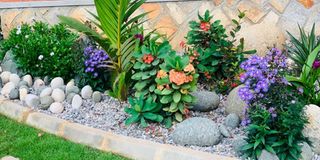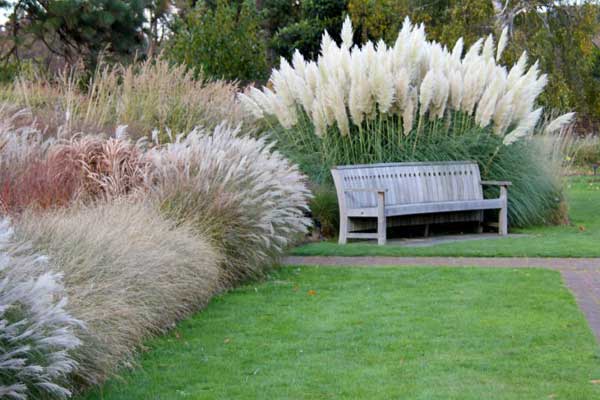How and why you should have a gravel garden

A gravel garden is usually low-maintenance with no lawn to mow. It is, therefore, essential to ensure it remains weed-free in order to stay neat and cozy. PHOTO | BEATRICE NAKIBUUKA
What you need to know:
- Creating a gravel garden is a great way to incorporate a wide range of plants that struggle to thrive without very well-drained soil. There is minimal watering and weeding.
Gravel gardens are low-maintenance, drought-resistant, ideal for small spaces but allow you to enjoy a variety of plants. Ethel Nambowa, a gardener and landscaper at Green Gardens, says a contemporary gravel garden designed with drought-tolerant plants can transform your landscape into a very space.
Drought-resistant
Creating a gravel garden is a great way to incorporate a wide range of plants that struggle to thrive without very well-drained soil. There is minimal watering and weeding. Also, such plants that enjoy dry soils tend to be more resistant to pests and disease. Making gardens more resistant to drought is becoming increasingly important if you want a garden that looks lush throughout the year.
They are eco-friendly
It is important to have outdoor spaces that are not only beautiful but also help to mitigate climate change and promote the ecosystem.
Nambowa says, “Landscaping with local, naturally sourced materials such as stone and gravel can cut down your carbon footprint from manufacturing and transport.”
Burglar deterrent
Gravel is not only pretty but it is also cheap and low-maintenance. The loud crunching noise it makes underfoot can be a good way to prevent a burglary. The burglars will always avoid gravel driveways and front gardens for this sound.
Use gravel to suppress weeds
“If your garden is a breeding ground for weeds, then gravel may be a solution. Fewer weeds grow in gravel gardens than they do in rich soil. With fewer weeds, your ground-cover plants can spread comfortably without being swamped by the competitors,” she says.
Low-maintenance
If you do not have a lot of time, or you are just not very green-fingered, then a gravel garden is an easy option. If you create your gravel garden correctly, it will be the most low-maintenance part of your garden.
It saves the time you would spend on pruning because there is little to do. Ideal for an informal path, gravel looks softer than solid paving and comes in a range of colours. It easily allows rainwater to soak through, helping to prevent flooding.
Nambowa recommends that you first remove all perennial weeds first in order to get the right balance of soil and gravel. If you do not put a thick enough layer of gravel onto heavy soil, the weeds will easily grow.
Create focal points
Nambowa remarks that, “Garden paths are a great way to define and separate areas of your garden and encourage visits and focal points even to the furthest corners of your landscape.”
She recommends laying gravel for a beautiful, meandering path through the garden with lawn and flowerbeds to a sitting area between trees.
Gravel paths with neatly defined visible edges or plants spilling over are very economical, easy to construct and are suitable for both city and country gardens.
Choose the right plants
When it comes to choosing plants, focus on evergreen species, interspersed with bulbs to add a seasonal splash of colour. Many drought-resistant plants grow naturally in dry and stony soil and will flourish in gravel gardens. The plants such as succulents, rockroses, lavender and euphorbias are great choices for gravel gardens.
A gravel garden is usually low-maintenance with no lawn to mow. It is therefore, essential to ensure that it remains weed free in order to stay neat and cozy.
Be vigilant with weeding in the first few years until the plants are large enough to suppress them. Self-seeding plants will pop up and give the garden a natural look; if they are a bit too many simply remove some.
Gravel garden ideas
Nambowa recommends a traditional rockery or use coloured aggregates to brighten a shady corner; and play with a mix of stones, such as boulders, cobbles and pebbles of different sizes mixed with bright coloured plants.
Gravel can also be used to soften hard-paved edges and to unify unrelated areas in the garden but you do not need to mix the gravel into the soil but instead just put it on top.
A gravel garden enhances the look of your outdoor space. You can use gravel as an outline path to your front door, a walkway that strolls around your back garden, or a destination path that leads to a particular spot. You can also plant flowers along the gravel passageway, create blurred boundaries and transitional zones between features such as a lawn, pond and garden borders using gravel and pebbles.
If you are tired of mowing your grass all the time, you can replace lawn or paving with areas of gravel or sand to balance planting. Arrange stepping stones in a winding path through the garden while avoiding straight lines. You can arrange large stones or groups of pebbles, as focal points to give a sense of rhythm. You can also rake gravel or sand into circles or lines around the stones to represent rippling waves or flowing water. Choose a colour palette that will help promote a calming sense in your landscape.




